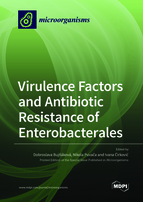Virulence Factors and Antibiotic Resistance of Enterobacterales
A special issue of Microorganisms (ISSN 2076-2607). This special issue belongs to the section "Antimicrobial Agents and Resistance".
Deadline for manuscript submissions: closed (31 May 2022) | Viewed by 31719
Special Issue Editors
Interests: Enterobacterales; virulence factors; antibiotic resistance; biofilm; quorum sensing
Special Issues, Collections and Topics in MDPI journals
Interests: animal science; nutrition; antimicrobials; antibiotic alternatives; veterinary; biotechnology; genetics; toxicology
Special Issues, Collections and Topics in MDPI journals
Interests: Enterobacterales; antimicrobial resistance; biofilm; human medicine
Special Issues, Collections and Topics in MDPI journals
Special Issue Information
Dear Colleagues,
The heterogeneous group of Gram-negative bacteria such as Escherichia coli and non-Escherichia coli Enterobacterales (e.g., Klebsiella, Enterobacter, Citrobacter) that can colonize the gastrointestinal tract of humans and animals and persist as gut commensals without inducing any infections in the environment with balanced microbiota (colonization resistance) also harbor features responsible for virulence and pathogenicity, including “fitness factors” or phenotypes that may result in severe health concerns, such as biofilm formation and/or multidrug resistance. Pathogenic Enterobacterales isolated from infected patients are the most often investigated, but also fecal isolates from healthy subjects including food, companion, and wild animals and/or food or environmental strains should be a more frequent target, aiming to determine the pathogenic potential of a wider biodiversity reservoir.
This Special Issue invites researchers interested in Enterobacterales characterization concerning the presence of genes associated with virulence (adhesins; surface cellulose structures and curli; siderophores, e.g., enterobactin, aerobactin, and yersiniabactin; protectines; invasins or toxins), and, furthermore, bacterial-biofilm-associated phenotypes. Although not directly involved in pathogenicity, the acquisition of multiple antibiotic resistances strongly supports the success of opportunistic Enterobacterales pathogens in invasion, survival, and spread and markedly complicates the treatment of infections. Not only pathogens but also commensal bacteria, considered harmless and part of the normal microbiota, are exposed to selection pressure and can be a reservoir of mobile genetic elements carrying antibiotic resistance genes. Therefore, the occurrence of drug-resistant bacteria within a commensal population and the possibility to exchange genetic material through horizontal gene transfer may represent a major health concern. Research papers, up-to-date review articles, and commentaries dealing with resistance, virulence, and biofilm in Enterobacterales are all welcome.
Dr. Dobroslava Bujňáková
Prof. Dr. Nikola Puvača
Prof. Ivana Ćirković
Guest Editors
Manuscript Submission Information
Manuscripts should be submitted online at www.mdpi.com by registering and logging in to this website. Once you are registered, click here to go to the submission form. Manuscripts can be submitted until the deadline. All submissions that pass pre-check are peer-reviewed. Accepted papers will be published continuously in the journal (as soon as accepted) and will be listed together on the special issue website. Research articles, review articles as well as short communications are invited. For planned papers, a title and short abstract (about 100 words) can be sent to the Editorial Office for announcement on this website.
Submitted manuscripts should not have been published previously, nor be under consideration for publication elsewhere (except conference proceedings papers). All manuscripts are thoroughly refereed through a single-blind peer-review process. A guide for authors and other relevant information for submission of manuscripts is available on the Instructions for Authors page. Microorganisms is an international peer-reviewed open access monthly journal published by MDPI.
Please visit the Instructions for Authors page before submitting a manuscript. The Article Processing Charge (APC) for publication in this open access journal is 2700 CHF (Swiss Francs). Submitted papers should be well formatted and use good English. Authors may use MDPI's English editing service prior to publication or during author revisions.
Keywords
- enterobacterales
- virulence factors
- antibiotic resistance
- biofilm
- healthy and sick animals
- commensal and pathogenic bacteria








